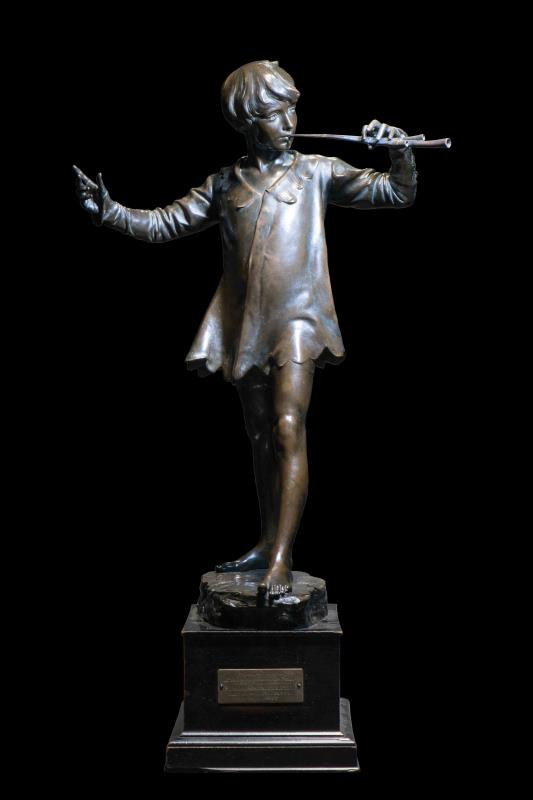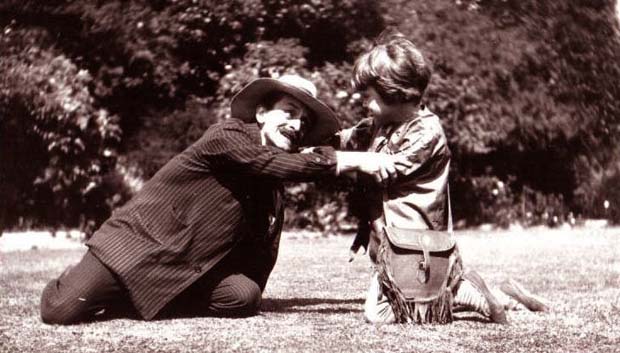
Since World Book Day is near, we thought we’d write about a certain Scottish Novelist and Playwright who has a strong connection with a small bronze statue in our collection, a famous arctic explorer, and stories of courage.
The writer in question is Sir James Matthew Barrie (1860-1937), who grew up in Scotland and worked in London, and is best known for creating the character of Peter Pan. His full play was titled Peter Pan: A Boy Who Wouldn’t Grow Up and was written in 1904 and later adapted into a novel in 1911. In the story, the main character is a magical boy who can fly and never grows up. Peter Pan perfectly encapsulates what it is like to be a child – the world is stuffed full of adventures to be had, and there are many dangers too which can be overcome only if you have the courage to face it.
When the Wardlaw Museum opens, Visitors will be able to see a statue of Peter Pan in our collection sculpted by Sir George Frampton. The statue was presented to the female students of University Hall by J.M. Barrie in 1922, and it was originally placed outside University Hall before becoming part of the Museum collections. At the time when the statue was placed, University Hall had been open since 1895 and was the first all-girls student accommodation in Scotland. The statue was very a popular feature within University Hall which for some has been sad to see it moved from it’s former home but it is hoped that being part of the exhibitions in the newly refurbished museum will allow many more to enjoy seeing this beautiful sculpture.

Peter Pan is indeed a much-loved literary character, and there are multiple statues of Peter Pan which can be found across the world. Our statue is a smaller version of one which was placed in Kensington Gardens in London. The Kensington Gardens statue is particularly magical because it appeared overnight in May 1912, and no one knew how it got there or who placed it there. The statue of Peter was supposed to be modelled upon photographs of Michael dressed as Peter Pan. However, in the end a different child was used as a model for the sculpture, leaving Barrie disappointed with the result, believing “It doesn’t show the devil in Peter”.
During his life, J.M. Barrie was Rector of the University of St Andrews from 1919 to 1922. Although an acclaimed author, J.M. Barrie was terrified of giving his rectorial address, and put it off for a while because he was uncomfortable with public speaking, stating in his address ‘This is my first and last public appearance’. He was friends with the famous explorer Captain Robert Falcon Scott and was godfather to Scott’s son Peter. Barrie spoke about this friendship and was touched by Scott’s bravery and courage which he possessed to the end, and his refusal to give up hope. They were such close friends that Barrie was one of the seven people whom Scott wrote letters to shortly before passing away from hypothermia during his ill-fated Terra-Nova Antarctic expedition (1910-13), asking Barrie to take care of his wife Kathleen and son Peter.

As part of the role of being Rector, a rectorial address must be given. When Barrie gave his address on the 3rd May 1922, he gave it with a small fold of paper in his breast pocket. It was a letter from Captain Scott which spoke partly of Scott and his men singing and laughing cheerfully in their tent despite the sad situation they were in due to the unrelenting bad weather outside.
“. . . We are in a desperate state–feet frozen, etc., no fuel, and a long way from food, but it would do your heart good to be in our tent, to hear our songs and our cheery conversation”.
It turned out to be some of Captain Scott and his men’s final hours, and the letter was amongst the last he ever wrote. When Barrie died years later, the letter from Scott was still in his breast pocket.
Often, when we tell stories about successful people and their achievements (whether they be academic, or heroic acts of courage) it is easy to forget that the people we are talking about are human. It is easy to forget that they get scared, that they have fears and doubts. I am sure that Captain Scott and his men were very scared in their tent, and that J.M. Barrie was very very scared of giving his rectorial address. But what makes them brave is that they managed to act despite their fears, it is this which transforms them (and anyone who can face their fears) into heroes. Captain Scott and his men had courage to stay hopeful and cheery to the end, which in turn inspired J.M. Barrie to face his fear of public speaking and commit his own act of courage and in turn inspire others.
Such stories of courage are valuable in times like these, where each of us must have courage to help others as much as we can, and the courage to maintain the hope that there are better days ahead.
There are a great many courageous characters to be found in the pages of books. Indeed, in Peter Pan, Peter has the courage to face the fearsome Captain Hook and all his pirates, and the children have the courage to make the journey to Neverland where they have many magical adventures.
We will end on the following quote from J.M. Barrie’s Peter Pan which discusses bravery:
“There are many different kinds of bravery. There’s the bravery of thinking of others before oneself. Now, your father has never brandished a sword nor fired a pistol, thank heavens. But he has made many sacrifices for his family, and put away many dreams.
Michael: Where did he put them?
Mrs. Darling: He put them in a drawer. And sometimes, late at night, we take them out and admire them. But it gets harder and harder to close the drawer… He does. And that is why he is brave.”
We are very grateful to our student volunteer bloggers who help us to produce the content for our museums blog! This blog was written by Kat McLaren currently studying for an MLitt in Museum and Galleries Studies at the University of St Andrews. Kat was really inspired by Barrie’s rectorial address from 1922 on courage and maybe you will too! Wishing you all a very happy World Book Day from all of us at the University of St Andrews Museums!